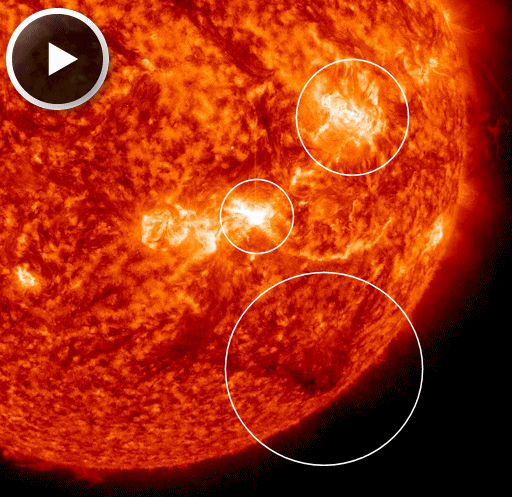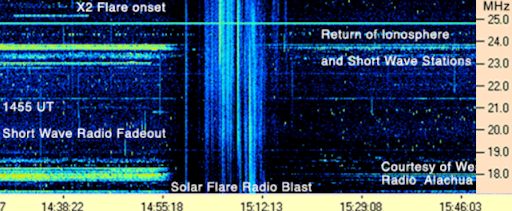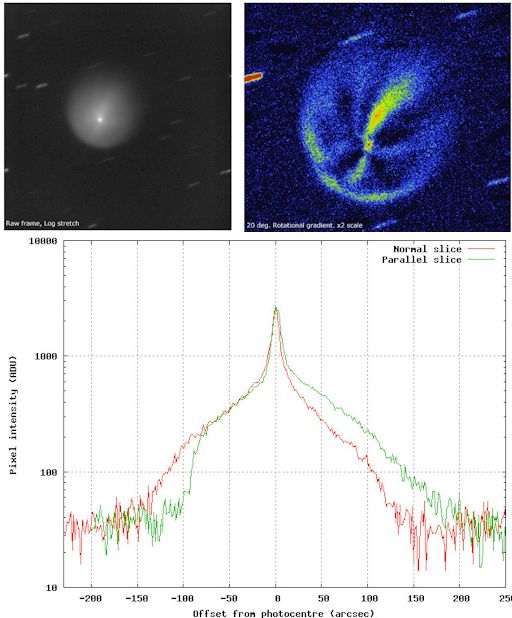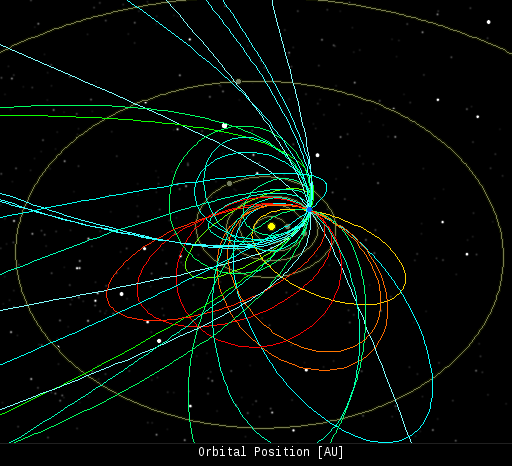Listen to radar echoes from satellites and meteors, live on listener-supported Space Weather Radio. | | |
WEEKEND FORECAST: Solar activity remains high. NOAA forecasters estimate a 70% chance of M-flares and a 35% chance of X-flares during the next 24 hours. Over the next three days (Oct. 26-28), a series of CMEs created by the recent limb eruptions will deliver glancing blows to Earth's magnetic field, possibly sparking polar geomagnetic storms. Aurora alerts: text, voice.
INTERCONNECTED SOLAR ACTIVITY: The X1-flare of Oct. 25th was remarkable not only for its strength, but also for its interconnectedness. The flare was bracketed by two erupting magnetic filaments, each located hundreds of thousands of kilometers from the instigating sunspot AR1882. The whole episoide, shown in this SDO movie, was reminiscent of the famous global eruption of August 2010.
Today, Oct. 26th, it happened again. Click on this image of the sun's southwestern quadrant and watch a sequence of flare activity around sunspots AR1875 and AR1877 followed by a filament eruption off the SW limb:

Instead of being a sequence of unrelated events, these flares and eruptions are likely connected by magnetic fields, which thread through the whole broad region. Like dominoes falling, one explosion triggers another as shock waves follow magnetic fields from blast site to blast site.
The filament punctuated the sequence by hurling a part of itself into space. SOHO has observed a CME emerging from the blast site, but it is too soon to say whether it is heading for Earth. Stay tuned for updates. Solar flare alerts: text, voice.
Realtime Space Weather Photo Gallery
X2-FLARE BLASTS EARTH'S IONOSPHERE: Electromagnetic radiation from yesterday's X2-class solar flare had a significant effect on Earth's upper atmosphere. As a wave of ionization swept across the dayside of the planet, the normal propagation of shortwave radio signals was scrambled. In Alachua, Florida, electrical engineer Wes Greenman recorded the effects using his own shortwave radio telescope. Click on the frequency-time plot to view an animation:

During the time that terrestrial shortwave transmissions were blacked out, the sun filled in the gap with a loud radio burst of its own. In New Mexico, amateur radio astronomer Thomas Ashcraft recorded the sounds. "This radio burst was a strong one and might be too intense for headphones," cautions Ashcraft.
Solar radio bursts are caused by strong shock waves moving through the sun's atmosphere. (Electrons accelerated by the shock front excite plasma instabilities which, in turn, produce shortwave static.) They are usually a sign that a CME is emerging from the blast site--and indeed this flare produced a very bright CME. Solar flare alerts: text, voice.
Realtime Space Weather Photo Gallery
COMET LINEAR X1: The sun isn't the only thing exploding. Almost 450 million km from Earth, Comet C/2012 X1 (LINEAR) is having its own outburst. On Oct. 20th, amateur astronomers realized that the comet's brightness had increased 100-fold and its morphology resembled that of exploding Comet 17P/Holmes in 2007. Follow-up images in recent nights seem to show jet-like structures in Comet LINEAR X1's expanding atmosphere. Amateur astronomer Nick James of Chelmsford, UK, obtained these data on Oct. 26th:

Another set of images taken by James shows the comet's atmosphere or "coma" expanding over a period of two days. "The coma's diameter is increasing at a rate of 30 arcseconds per day," says James. "At a distance of 2.95 AU this corresponds to 65,000 km/day or a little less than 1 km/s." He made these observations using an 11-inch Celestron telescope.
Located in the constellation Coma Berenices, Comet LINEAR X1 rises in the east about an hour before the sun. The low altitude of the comet in morning twilight is a challenge, but because the comet is fairly bright, magnitude +8.5, it is still a relatively easy target for backyard telescopes equipped with digital cameras. Monitoring is encouraged! Resources: 3D orbit, ephemeris, sky map.
Realtime Comet Photo Gallery
Realtime Comet ISON Photo Gallery
Realtime Aurora Photo Gallery
NEW: Every night, a network of
NASA all-sky cameras scans the skies above the United States for meteoritic fireballs. Automated software maintained by NASA's Meteoroid Environment Office calculates their orbits, velocity, penetration depth in Earth's atmosphere and many other characteristics. Daily results are presented here on Spaceweather.com.
On Oct. 26, 2013, the network reported 27 fireballs.
(16 sporadics, 7 Orionids, 1 Leonis Minorid, 1 epsilon Geminid, 1 Southern Taurid, 1 xi Draconid)

In this diagram of the inner solar system, all of the fireball orbits intersect at a single point--Earth. The orbits are color-coded by velocity, from slow (red) to fast (blue). [Larger image] [movies]
Potentially Hazardous Asteroids (
PHAs) are space rocks larger than approximately 100m that can come closer to Earth than 0.05 AU. None of the known PHAs is on a collision course with our planet, although astronomers are finding
new ones all the time.
On October 26, 2013 there were potentially hazardous asteroids.
Notes: LD means "Lunar Distance." 1 LD = 384,401 km, the distance between Earth and the Moon. 1 LD also equals 0.00256 AU. MAG is the visual magnitude of the asteroid on the date of closest approach. | | The official U.S. government space weather bureau |
| | The first place to look for information about sundogs, pillars, rainbows and related phenomena. |
| | Researchers call it a "Hubble for the sun." SDO is the most advanced solar observatory ever. |
| | 3D views of the sun from NASA's Solar and Terrestrial Relations Observatory |
| | Realtime and archival images of the Sun from SOHO. |
| | from the NOAA Space Environment Center |
| | the underlying science of space weather |

